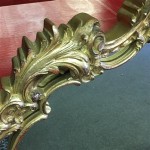What is the Word "Mirror Image" Mean?
The term "mirror image" refers to a reflected duplication of an object that appears almost identical, but reversed along a single axis. It's the visual representation one sees in a mirror, where the left and right sides are swapped. While appearing highly similar, a mirror image is not truly identical to the original object – it exhibits a specific type of symmetry known as lateral inversion.
Lateral inversion, also called mirror symmetry, is the key characteristic distinguishing a mirror image from a simple duplicate. This type of symmetry occurs when one half of an object is the reflection of the other half, with a central line, or axis, serving as the dividing point. Imagine folding a piece of paper in half and cutting a shape along the folded edge. Upon unfolding, the two halves will be mirror images of each other. They possess lateral inversion across the fold line.
The concept of mirror images extends beyond simple visual representations. It also has implications in various fields, including chemistry, physics, and mathematics. In chemistry, molecules can exist as mirror images of each other, known as enantiomers. These molecules have the same chemical formula and bonding arrangement, but differ in their three-dimensional spatial orientation. This seemingly minor difference can have significant consequences for their chemical and biological properties. For instance, one enantiomer of a drug might be effective in treating a disease, while its mirror image could be inactive or even harmful.
In physics, the concept of parity relates to mirror symmetry. Parity symmetry suggests that the laws of physics should be the same whether we observe a system directly or its mirror image. While this holds true for many physical interactions, certain weak nuclear forces violate parity symmetry. This discovery was a significant breakthrough in understanding the fundamental forces of nature.
Mathematics employs mirror symmetry in various geometric concepts. Reflections, a type of transformation, create mirrored images. A reflection across the x-axis, for instance, will transform a point (x, y) into (x, -y). Similarly, a reflection across the y-axis transforms (x, y) to (-x, y). These reflections are fundamental operations in geometry and contribute to understanding symmetry and spatial relationships.
The distinction between a "mirror image" and a "duplicate" is crucial. A duplicate is an exact copy, replicating all aspects of the original. A mirror image, however, differs specifically in its lateral inversion. Consider the human hand: while the left and right hands appear very similar, they are not interchangeable. Trying to fit a right-handed glove onto a left hand illustrates the non-superimposable nature of mirror images. They are similar, yet distinct.
The phenomenon of mirror images is readily observable in everyday life. From the reflection in a still pond to the rearview mirror in a car, we encounter mirror images constantly. These reflections remind us of the concept of symmetry and its implications in the world around us. The reversed lettering on the front of ambulances is a practical application of mirror images. Drivers seeing the reversed lettering in their rearview mirrors can correctly read the word "AMBULANCE" and react accordingly.
Understanding the concept of mirror images and lateral inversion enhances our comprehension of various scientific and mathematical principles. Recognizing the subtle yet significant difference between a true copy and a mirrored reflection unveils deeper insights into the properties of objects, molecules, and even fundamental physical laws. While the visual aspect of a mirror image is easily grasped, its broader implications span numerous fields of study, emphasizing the importance of this concept beyond simple reflection.
Furthermore, the prevalence of mirror images in art and design highlights its aesthetic appeal. The inherent balance and symmetry often found in mirror images contribute to a sense of harmony and visual pleasure. From architectural designs incorporating mirrored facades to artistic patterns exploiting reflectional symmetry, the concept of mirror images finds creative expression in various forms.
Mirror images also play a role in psychology and self-perception. The "mirror stage" in developmental psychology describes the phase where infants recognize themselves in a mirror, marking an important step in the development of self-awareness. This recognition of the self as separate from the external world is a significant milestone in cognitive development and highlights the psychological dimension of the mirror image concept.
In conclusion, the term "mirror image" encompasses a diverse array of meanings and applications. From its everyday visual manifestation to its intricate roles in scientific disciplines and creative fields, understanding the concept of mirror images and the underlying principle of lateral inversion provides a deeper understanding of several aspects of the world around us. This exploration into the multifaceted nature of mirror images illuminates its significance beyond mere reflection, demonstrating its impact on diverse fields and revealing its inherent complexity.

Class 9th English Beehive Prose Chapter 5 Word Meanings

The Word Mirror Comes From Latin Mirari Meaning To Wonder At

Ambigram Wikipedia

Mirror Equation Formula Sign Conventions Explanation Problem

Many Ways To Flip Reverse And Mirror Text In Microsoft Word Office Watch

Mirror Photo Picture Definition At Dictionary Word And Phrase Defined By Its Image In Jpg Jpeg English

Mirror First Name Personality Popularity

Mirror Equation Formula Sign Conventions Explanation Problem

How To Set Mirror Margins In Your Microsoft Word Documents Change Adjust View Page Setup

Page 148 Science Class 07








